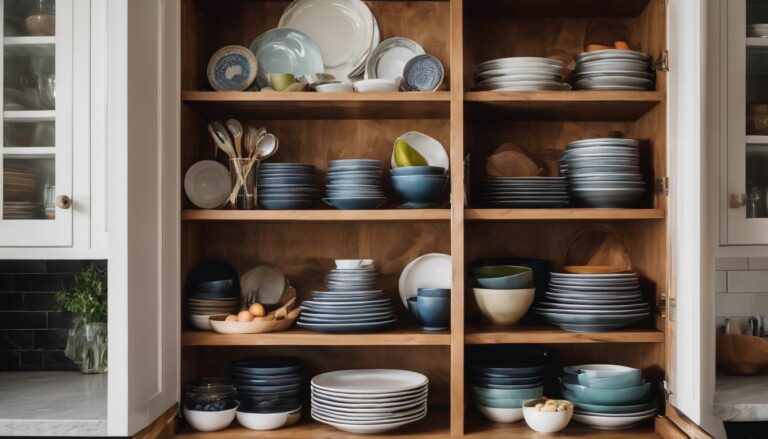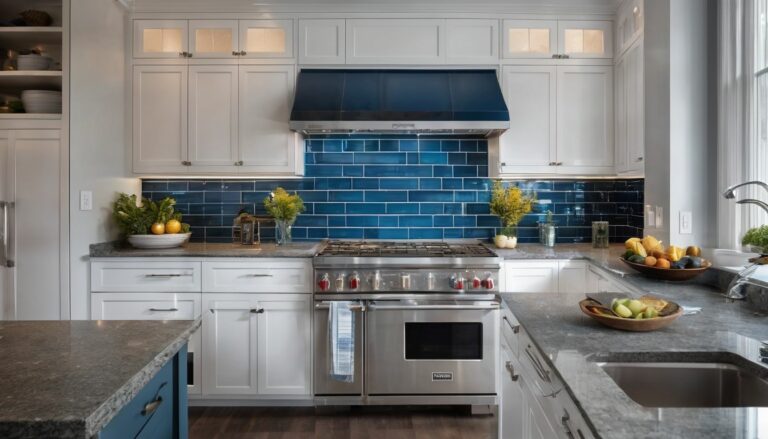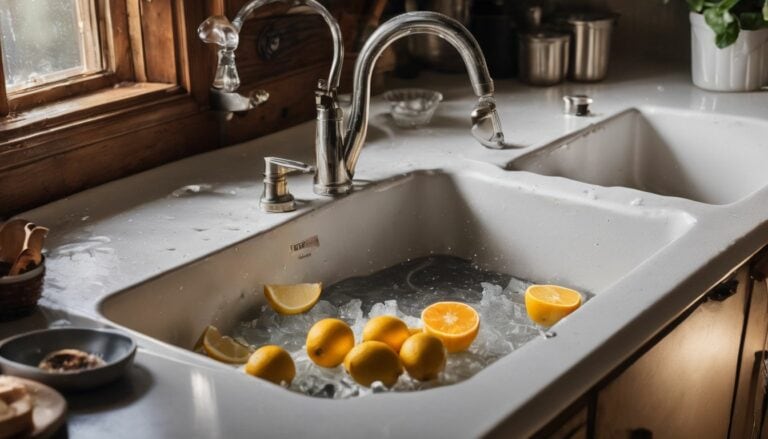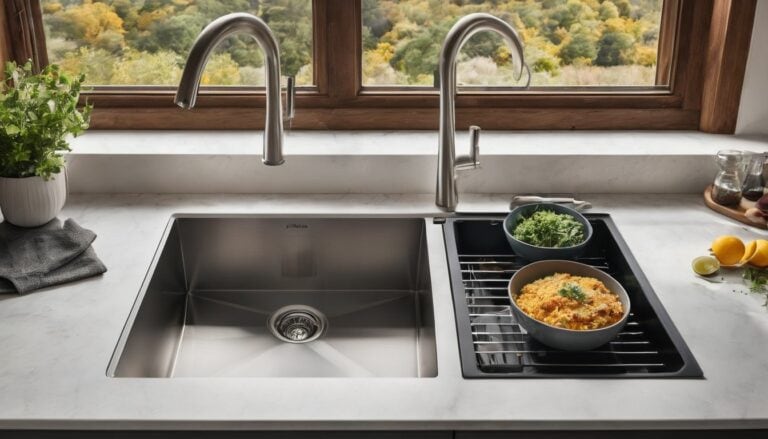Get Answers: Can You Plunge a Kitchen Sink with a Garbage Disposal
Ever squared off with a kitchen sink that’s clogged tighter than a drum, even with a garbage disposal? You’re not alone – it turns out nearly 70% of homeowners have wrestled this common plumbing goblin at some point.
But don’t despair, I’ve compiled an easy-to-follow guide to help you banish that stubborn clog using simple tools. So, grab your rubber gloves and let’s dive into the solution right in the comfort of your home!
Key Takeaways
- Almost 70% of homeowners have dealt with a clogged kitchen sink with a garbage disposal at some point.
- Common causes include putting the wrong items down the disposal, grease buildup, and insufficient water flow.
- Essential tools for unclogging include a plunger, baking soda, vinegar, tongs, pliers, wet – dry vacuum, and an auger/snake.
- Safety precautions are important: unplug the disposal before starting work,don’t use chemical cleaners,and protect your hands and eyes.
Common Causes of a Clogged Kitchen Sink with a Garbage Disposal

There are several common causes of a clogged kitchen sink with a garbage disposal, including putting the wrong items down the disposal, grease buildup, and insufficient water flow.
Putting the wrong items down the disposal
Putting stuff in the disposal that doesn’t belong is easy. But it can cause big problems, like blockage! Food bits pile up and can make clogs too. Sometimes we put things down there that are too hard or big for the disposal to cut up.
It’s not meant to take everything! This can mess up the unit and lead to clogs. So, let’s be careful about what goes in there to keep our sinks working right.
Grease buildup
Grease buildup is a big reason for clogs in the kitchen sink. You might not know this, but grease sticks to pipes over time. This leads to serious blockages in your sink’s drainage pipe.
The more grease you put down the disposal, the bigger the problem gets.
Imagine pouring warm oil into a cold glass. It turns hard and sticks to everything it touches. The same thing happens in your garbage disposal and pipes when you pour grease down there! That’s why it’s important to watch out for this common issue that causes kitchen plumbing problems.
Insufficient water flow
Not using enough water can clog your sink. This is because food waste needs a lot of water to go down the drain. If there’s not enough, food sticks in the pipes and stops water from passing through.
This makes your sink fill up with more water than it should have and slows down how fast things drain out. To see if this is your problem, you can use hot water! Just turn on the faucet and see if it clears away any standing water in the sink or speeds up slow drainage.
Do this regularly for better results!
Can You Plunge a Kitchen Sink with a Garbage Disposal: Tools and Materials Needed
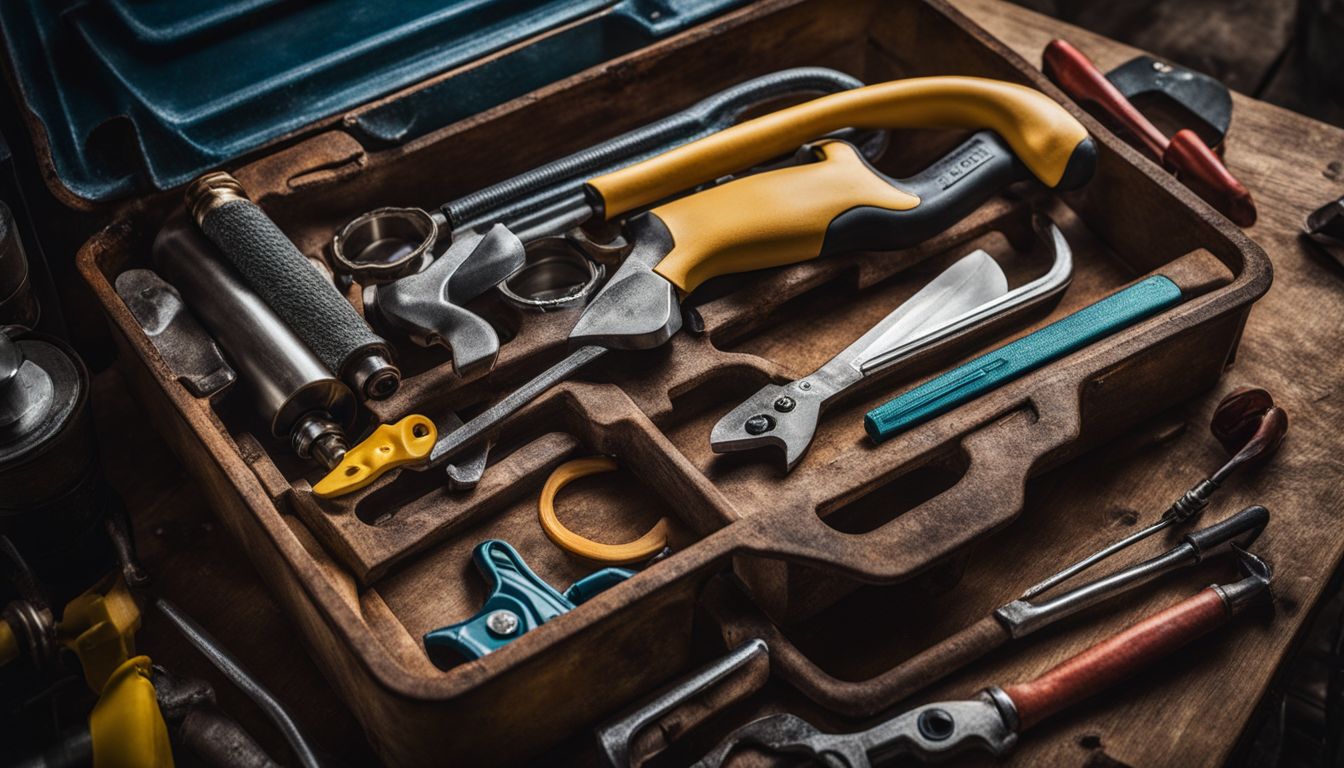
To successfully unclog a kitchen sink with a garbage disposal, you will need a plunger, baking soda, vinegar, water, tongs, pliers, wet-dry vacuum, and an auger/snake.
Plunger
When it comes to unclogging a kitchen sink with a garbage disposal, a plunger can be your best friend. I recommend using a cup plunger with a flat rim for small clogs in the sink. This type of plunger creates a seal over the sink hole, allowing you to apply the necessary pressure to unclog the drain.
To use the plunger, simply place it over the drain and rapidly plunge up and down. This motion helps build up water pressure and loosen any clogs in the disposal drain. Remember, a sink plunger can also be used to unclog a garbage disposal if needed.
Baking soda
Baking soda is a helpful and natural cleaner that can be used to unclog your kitchen sink. It has slight disinfectant properties that fight against odor-causing bacteria and fungi, keeping your sink smelling fresh.
Regularly cleaning your sink with baking soda can also prevent clogs from happening in the first place. If you have a garbage disposal, you can even use baking soda in combination with white vinegar to unclog the drain.
However, it’s important to note that baking soda should not be used together with vinegar when trying to unclog a regular drain. Remember to always follow the instructions carefully and take necessary safety precautions when using baking soda for cleaning purposes.
Vinegar
When it comes to unclogging a kitchen sink with a garbage disposal, vinegar is a handy tool. It can be used in combination with baking soda as a natural and eco-friendly cleaning solution.
Pouring baking soda followed by vinegar down the drain can help break up clogs and clear the blockage. Vinegar’s acetic acid properties work effectively to dissolve grease buildup and other debris that may be causing the clog.
So, if you’re looking for a household cleaner that is gentle yet effective in tackling plumbing problems, vinegar is definitely worth considering.
Water
When unclogging a kitchen sink with a garbage disposal, water is an important element to consider. Lack of sufficient water flow can lead to blockages over time, so it’s important to ensure proper flushing when disposing of food waste.
Running cold water while using the garbage disposal can also help loosen any food that may be stuck in the unit. Additionally, when trying different methods like plunging or using a natural drain cleaner, having standing water in the sink can make these techniques more effective.
Just remember not to use boiling water as it can damage your kitchen sink.
Tongs
When unclogging a kitchen sink with a garbage disposal, tongs can be really useful. They are one of the tools or materials needed to get the job done. Tongs can help remove any obstructions from the disposal opening, like pieces of clogs or loose objects that may be causing the clog.
You can also use them to manually pull out any clog pieces from the garbage disposal. So don’t forget to have a pair of tongs handy when you’re tackling that pesky clogged sink!
Pliers
Pliers are important tools when it comes to unclogging a kitchen sink with a garbage disposal. They can be really helpful for reaching into the disposal opening and removing any obstructions that may be causing the clog.
You can use the pliers to loosen the drain trap and catch any debris in a bucket below. Pliers are also useful for manually rotating the blades of a garbage disposal, which can help dislodge stubborn clogs.
So if you’re dealing with a clogged sink, don’t forget to have a pair of pliers on hand!
Wet-dry vacuum
I love using a wet-dry vacuum when it comes to unclogging my kitchen sink with a garbage disposal. It’s such a handy tool to have! Wet-dry vacuums are really effective at clearing clogs caused by grease or overworked garbage disposals.
They can easily remove any debris or clogs in the sink, preventing pipe damage. Plus, these vacuums can also be set to vacuum liquids, which makes them perfect for unclogging drains.
If you’re a DIY homeowner dealing with kitchen sink clogs, I highly recommend having a wet-dry vacuum on hand. It’s definitely an essential tool!
Auger/snake
One of the tools you’ll need to unclog your kitchen sink with a garbage disposal is an auger or snake. This long, flexible tool has metal bristles at the end and is designed to break up stubborn clogs in your drain.
It’s like a little superhero for your plumbing! A manual snake has a cable with a hook, making it easy to navigate through the pipe and grab onto any debris causing the clog. With this simple but effective tool, you can clear those tough clogs without having to call a plumber.
Safety Precautions
To ensure your safety while unclogging a kitchen sink with a garbage disposal, be sure to unplug the disposal before starting any work. Avoid using chemical cleaners, as they can damage the disposal and create harmful fumes.
And always remember to protect your hands and eyes by wearing gloves and safety goggles throughout the process.
Unplugging the disposal
Before starting any unclogging procedures, it’s very important to turn off and unplug the garbage disposal. This is for safety reasons as you don’t want the disposal to accidentally turn on while you’re working on it.
To unplug the disposal, simply find the electrical outlet that it’s connected to and remove the plug from the socket. Once it’s unplugged, you can proceed with clearing the clog without worrying about any accidents happening.
Safety should always be a top priority when dealing with appliances like garbage disposals.
Additionally, if there are any large objects or debris stuck in the disposal, use tongs or pliers to carefully remove them. Avoid using your hands directly as this can be dangerous.
Avoiding chemical cleaners
I always try to avoid using chemical cleaners when unclogging my kitchen sink with a garbage disposal. Harsh drain cleaners can actually damage the plastic parts inside the disposal, so it’s best to steer clear of them.
Instead, I opt for nontoxic and environmentally friendly alternatives. Baking soda and vinegar work wonders as a natural solution for unclogging drains. They create a fizzy, foaming reaction that helps break up clogs without any harmful chemicals.
Not only are these homemade remedies safe for both your sink and the environment, but they’re also much gentler on your pipes. So, next time you have a clog in your kitchen sink with a garbage disposal, remember to choose chemical-free cleaning options like baking soda and vinegar!
Protecting your hands and eyes
When unclogging a kitchen sink with a garbage disposal, it’s important to keep your hands and eyes safe. You can protect your hands by wearing rubber gloves or using tongs when handling dirty water or debris.
This will help prevent any cuts or injuries. To protect your eyes, consider wearing safety goggles to shield them from splashing water or any small particles that could potentially cause harm.
Safety is key when dealing with clogs, so remember to take precautions and keep yourself protected throughout the process.
How to Unclog a Kitchen Sink with a Garbage Disposal
To start, make sure the garbage disposal is turned off and unplugged. Then, use a plunger to create suction over the drain and plunge vigorously a few times to dislodge any clogs. If that doesn’t work, try using baking soda and vinegar to break down any remaining debris.
For stubborn clogs, you may need to remove large objects with tongs or pliers, or even use an auger/snake to clear the blockage. Read on for more detailed instructions on how to unclog your kitchen sink with ease!
Steps for plunging the sink
To unclog a kitchen sink with a garbage disposal, follow these simple steps for plunging the sink. First, make sure there is enough water in the sink to cover the lip of the plunger.
Then position the plunger over the drain and push down firmly and quickly. Keep doing this vigorous up-and-down motion for about 15 to 20 seconds. The water pressure created by plunging can help dislodge and move the clog down the pipes.
Afterward, check if the water drains properly. If it does, you’ve successfully cleared the clog using this plumbing method!
Using baking soda and vinegar
When it comes to unclogging a kitchen sink with a garbage disposal, using baking soda and vinegar can be an effective solution. These household items work together to break down mineral deposits that cause blockages in the sink drain.
To use this method, simply pour one cup of baking soda into the garbage disposal, followed by one cup of white vinegar. Let the mixture sit for about 20 minutes before running hot water down the disposal to flush out any remaining debris.
This natural and DIY approach is a safe and cost-effective way to clear your sink drain without resorting to harsh chemicals or calling a professional plumber.
Removing large objects
To remove large objects stuck in your kitchen sink with a garbage disposal, you can use tongs. Simply reach into the sink and carefully grab the object with the tongs, making sure not to damage the blades of the garbage disposal.
This method is effective for items like silverware or small utensils that may have fallen into the sink by accident. By using tongs, you can safely retrieve these objects and prevent further clogging or damage to your disposal.
Rotating the garbage disposal blades
To unclog a kitchen sink with a garbage disposal, you can try rotating the blades of the disposal. The blades are designed to chop up food scraps and prevent clogs in the drain pipe.
By manually turning the blades, you can dislodge and break down any clogs that may be causing the sink to back up. You can use a wooden handle or an Allen wrench to turn the blades and help clear the clog.
It’s important to remember to unplug the disposal before attempting this method for safety reasons.
Tips and Tricks
To prevent future clogs, make regular maintenance and cleaning of your garbage disposal a priority. By running cold water while using the disposal, avoiding putting fibrous or starchy foods down the drain, and periodically grinding ice cubes to freshen the blades, you can keep your sink clog-free and your garbage disposal operating smoothly.
Regular maintenance and cleaning to prevent clogs
Regular maintenance and cleaning are essential for preventing clogs in your kitchen sink with a garbage disposal. By taking simple steps to keep your sink clean, you can avoid blockages and maintain good plumbing hygiene.
Grease, fat, and oil should never be poured down the drain as they can harden and cause clogs. It’s also important to avoid grinding coffee grounds and eggshells in the disposal as they can form a sludgy paste that leads to blockages.
To prevent clogs, regularly clean your sink drain by flushing it with hot water or using a mixture of baking soda and vinegar. Running the garbage disposal frequently helps keep its parts moving smoothly and prevents rust or obstructions from building up.
Using ice cubes to freshen the disposal
I love using ice cubes to freshen my garbage disposal! It’s a simple and effective method for keeping it clean and odor-free. When you put a few ice cubes down the disposal while running cold water, they can help break up any food particles that may be stuck on the blades.
The cold water also helps to solidify any grease or oil, making it easier for the ice cubes to remove them. Plus, as the ice cubes melt, they leave behind a refreshing scent in your disposal.
It’s such an easy and affordable way to maintain your garbage disposal and keep it running smoothly.
Expert Q&A
Now, let’s address some common questions you may have about unclogging a sink with a garbage disposal.
Answers to common questions about unclogging a sink with a disposal
I often receive questions about how to unclog a sink with a garbage disposal. One common question is, “Can I use chemical cleaners?” It’s best to avoid using chemical cleaners as they can damage the disposal and pipes.
Another question I get is, “What if the plunger doesn’t work?” If plunging the sink doesn’t do the trick, you can try using a mixture of baking soda and white vinegar. This can help break up any clogs in the pipes.
Remember to always check if there are any large objects stuck in the sink before attempting any unclogging methods.
When to Call a Professional
If you notice any signs of a more serious clog or issue, it may be time to call a professional plumber. They have the expertise and tools necessary to handle complex clogs or potential damage to your garbage disposal.
Don’t hesitate to seek their help if you’re unsure or if DIY methods haven’t resolved the problem.
Signs of a more serious clog or issue
If you notice some signs while trying to unclog your kitchen sink with a garbage disposal, it may mean that there is a more serious clog or issue. These signs can include water backing up in other drains in your home, gurgling noises coming from the pipes, foul odors coming from the sink, or slow drainage even after attempting to unclog it.
In some cases, these issues could be caused by drain line clogs or damage from tree roots. If you experience any of these signs, it’s best to call a professional plumber for help.
Reasons to hire a plumber
If you’ve tried all the DIY methods and your kitchen sink is still clogged, it’s time to call a professional plumber. They have the experience and tools needed to tackle stubborn clogs that won’t budge.
Plus, if your garbage disposal unit is faulty or needs replacing, a plumber can take care of that too. Remember, while hiring a plumber may cost around $300 on average, it can save you time and hassle in the long run.
So don’t hesitate to reach out to a licensed plumbing contractor when you need expert help with your kitchen plumbing issues.
Additional Resources
For more information on unclogging your kitchen sink with a garbage disposal, check out these helpful articles and guides.
Articles and guides for further information
If you want to learn more about unclogging your kitchen sink with a garbage disposal, there are plenty of helpful articles and guides available. You can find techniques for clearing a clogged drain on your own without needing to hire a professional.
These resources will provide step-by-step instructions and DIY methods for unclogging your sink safely. They will also offer tips on precautionary measures to take before starting the process, such as turning off the garbage disposal and avoiding chemical cleaners.
Additionally, you can find information on using hot water effectively to clear clogs and following the manufacturer’s instructions carefully. Remember, regular maintenance and cleaning are key to preventing future clogs!
Conclusion
In conclusion, unclogging a kitchen sink with a garbage disposal can be done using simple tools and materials like a plunger, baking soda, vinegar, and water. By following the steps outlined in this guide, you can easily tackle common clogs caused by things like grease buildup or objects stuck in the sink.
Remember to follow safety precautions and consider calling a professional if the clog persists or if there are signs of a more serious issue. With these tips and tricks, you’ll have your sink unclogged with ease!
FAQs
1. Can I use a plunger to unclog my kitchen sink if it has a garbage disposal?
Yes, you can use a plunger to unclog your kitchen sink even if it has a garbage disposal.
2. How do I properly use a plunger to unclog my kitchen sink?
To use the plunger effectively, place it over the drain opening and create a strong seal. Then, push and pull the plunger vigorously to generate suction and dislodge the clog.
3. What should I do if plunging doesn’t fix the clogged kitchen sink?
If plunging doesn’t work, you can try using other DIY methods like using baking soda and vinegar or removing the P-trap under the sink to clear out any debris.
4. Should I turn off my garbage disposal before attempting to plunge my kitchen sink?
Yes, it is recommended to turn off your garbage disposal before attempting to plunge your kitchen sink. This ensures safety and prevents any damage from occurring.
5. When is it time to call a professional plumber for help with my clogged kitchen sink?
You should consider calling a professional plumber if none of the DIY methods are successful in unclogging your kitchen sink or if you are uncomfortable performing these tasks yourself


